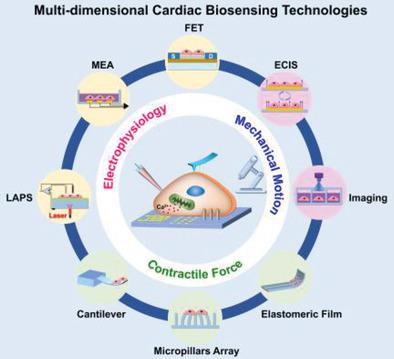Our official English website, www.x-mol.net, welcomes your
feedback! (Note: you will need to create a separate account there.)
Advances in Multidimensional Cardiac Biosensing Technologies: From Electrophysiology to Mechanical Motion and Contractile Force
Small ( IF 13.0 ) Pub Date : 2020-11-23 , DOI: 10.1002/smll.202005828 Xinwei Wei 1, 2 , Liujing Zhuang 1, 2 , Hongbo Li 3 , Chuanjiang He 1 , Hao Wan 1, 2 , Ning Hu 3 , Ping Wang 1, 2
Small ( IF 13.0 ) Pub Date : 2020-11-23 , DOI: 10.1002/smll.202005828 Xinwei Wei 1, 2 , Liujing Zhuang 1, 2 , Hongbo Li 3 , Chuanjiang He 1 , Hao Wan 1, 2 , Ning Hu 3 , Ping Wang 1, 2
Affiliation

|
Cardiovascular disease is currently a leading killer to human, while drug‐induced cardiotoxicity remains the main cause of the withdrawal and attrition of drugs. Taking clinical correlation and throughput into account, cardiomyocyte is perfect as in vitro cardiac model for heart disease modeling, drug discovery, and cardiotoxicity assessment by accurately measuring the physiological multiparameters of cardiomyocytes. Remarkably, cardiomyocytes present both electrophysiological and biomechanical characteristics due to the unique excitation–contraction coupling, which plays a significant role in studying the cardiomyocytes. This review mainly focuses on the recent advances of biosensing technologies for the 2D and 3D cardiac models with three special properties: electrophysiology, mechanical motion, and contractile force. These high‐performance multidimensional cardiac models are popular and effective to rebuild and mimic the heart in vitro. To help understand the high‐quality and accurate physiologies, related detection techniques are highly demanded, from microtechnology to nanotechnology, from extracellular to intracellular recording, from multiple cells to single cell, and from planar to 3D models. Furthermore, the characteristics, advantages, limitations, and applications of these cardiac biosensing technologies, as well as the future development prospects should contribute to the systematization and expansion of knowledge.
中文翻译:

多维心脏生物传感技术的进展:从电生理学到机械运动和收缩力
心血管疾病目前是人类的主要杀手,而药物引起的心脏毒性仍然是药物停药和损耗的主要原因。考虑到临床相关性和通量,心肌细胞非常适合作为体外心脏模型,用于心脏疾病建模,药物发现和心脏毒性评估,可通过准确测量心肌细胞的生理多参数来实现。值得注意的是,由于独特的激发-收缩耦合,心肌细胞同时具有电生理和生物力学特性,在研究心肌细胞方面起着重要作用。这项审查主要侧重于具有3个特殊属性的2D和3D心脏模型的生物传感技术的最新进展:电生理,机械运动和收缩力。这些高性能的多维心脏模型在体外重建和模仿心脏方面非常流行且有效。为了帮助理解高质量和准确的生理学,从微技术到纳米技术,从细胞外到细胞内记录,从多个细胞到单个细胞以及从平面到3D模型,对检测技术的要求都很高。此外,这些心脏生物传感技术的特征,优势,局限性和应用以及未来的发展前景应有助于知识的系统化和扩展。从微技术到纳米技术,从细胞外到细胞内记录,从多个细胞到单个细胞,以及从平面到3D模型。此外,这些心脏生物传感技术的特征,优势,局限性和应用以及未来的发展前景应有助于知识的系统化和扩展。从微技术到纳米技术,从细胞外到细胞内记录,从多个细胞到单个细胞,以及从平面到3D模型。此外,这些心脏生物传感技术的特征,优势,局限性和应用以及未来的发展前景应有助于知识的系统化和扩展。
更新日期:2020-12-17
中文翻译:

多维心脏生物传感技术的进展:从电生理学到机械运动和收缩力
心血管疾病目前是人类的主要杀手,而药物引起的心脏毒性仍然是药物停药和损耗的主要原因。考虑到临床相关性和通量,心肌细胞非常适合作为体外心脏模型,用于心脏疾病建模,药物发现和心脏毒性评估,可通过准确测量心肌细胞的生理多参数来实现。值得注意的是,由于独特的激发-收缩耦合,心肌细胞同时具有电生理和生物力学特性,在研究心肌细胞方面起着重要作用。这项审查主要侧重于具有3个特殊属性的2D和3D心脏模型的生物传感技术的最新进展:电生理,机械运动和收缩力。这些高性能的多维心脏模型在体外重建和模仿心脏方面非常流行且有效。为了帮助理解高质量和准确的生理学,从微技术到纳米技术,从细胞外到细胞内记录,从多个细胞到单个细胞以及从平面到3D模型,对检测技术的要求都很高。此外,这些心脏生物传感技术的特征,优势,局限性和应用以及未来的发展前景应有助于知识的系统化和扩展。从微技术到纳米技术,从细胞外到细胞内记录,从多个细胞到单个细胞,以及从平面到3D模型。此外,这些心脏生物传感技术的特征,优势,局限性和应用以及未来的发展前景应有助于知识的系统化和扩展。从微技术到纳米技术,从细胞外到细胞内记录,从多个细胞到单个细胞,以及从平面到3D模型。此外,这些心脏生物传感技术的特征,优势,局限性和应用以及未来的发展前景应有助于知识的系统化和扩展。











































 京公网安备 11010802027423号
京公网安备 11010802027423号